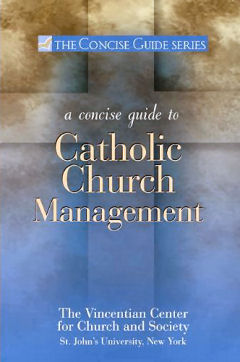
|
Posted August 12, 2010
Book: A Concise Guide to Catholic Church Management The Concise Guide Series: The Vincentian Center for Church and Society St. John’s University. New York. 2010. Pp. 269 An Excerpt from the Flyer:
For fifteen years, the Vincentian Center for Church and Society at St. John’s University has been successfully training priests and pastoral leaders in management concepts and skills. Built upon this wealth of experience, A Concise Guide to Catholic Church Management connects the theory of academic training with the hands-on skills of pastoral practice. As the contributing authors write in the preface, “This guide is not designed to make one an accountant, a paralegal, a human resource specialist, a planning expert, or genius communicator. Rather, it is designed to help the reader ask the right questions, understand the basics of specialized vocabularies, and develop proven skills. It also heightens sensitivity to the elements of organizational health and responsible stewardship.” Today’s pastoral leaders are required to understand effective communications, budgeting, staff management, and legal responsibilities – all through the lens of Catholic values and traditions. This veritable ministry bible offers pastors and administrators twelve succinct, informative chapters and is supplemented by over fifty free online materials including charts, graphs, checklists, and other resources. An Excerpt from the Book: Physical Comfort Many organizations desire to provide their clientele with a comfortable seat — perhaps to eat a meal, enjoy a rest, have a conversation, or just gaze at some pretty scenery. But many of these same organizations desire to turn over their clientele on a frequent basis. That is, customers are welcome to spend ten to twenty minutes in a chair or at a table. Then the organization would prefer that customers vacate the space and allow other customers to use the same resources. There are many examples of this common organizational desire. It’s true of fast food restaurants, museums, bus stops, municipal parks, and the like. These organizations have adopted a very similar and effective strategy to work their will on clientele without alienating patrons by asking them to leave. They motivate clientele to decide on their own to move to another activity by providing comfortably shaped yet hard seating surfaces, such as plastic-molded seats, metal café chairs, or wooden or marble benches. On thes seating surfaces, one is comfortable for a short period of time and one feels well served. After a short while, one is happy to vacate the seat. Aware of this universal seating strategy, how can requiring parishioners to sit on hard wooden pews for a fifty-to sixty-minute Sunday Mass be construed as good service? For many, this is not good service, but is, ikn fact, the opposite of good service. Parishioners might perceive this, if only on a subconscious level, as lack of comfort and therefore a lack of hospitality. A similar observation can be made about having to sit through Mass or meetings while wearing heavy jackets or coats, as opposed to having eay access to a coat room or coat racks. Another element of comfort involves the doors one has to use to access a venue. If a client is truly welcome to a service site, easy entry through its doors is assumed. Some houses of worship possess beautifully ornate — and heavey — doors. Their visual impact contributes to the church’s sacred environment. Yet parish administrators may not have taken the small amount of trouble necessary to confirm that a properly functioning hydraulic assist wold provide the necessary help needed to open the door for a weaker-than-normal worshiper or an elderly or young person. Every obstacle encountered by a parishioner — even one that seems as inconsequential as a door that is challenging to open — delivers a small psychological message. The sum total of these messages can cause a parishioner to conclude, “They really don’t welcome me here.” Table of Contents: 1. Leadership 2. Fundamentals of management 3. Time management 4. Communication: the oxygen of an organization 5. Meetings 6. The parish and service quality 7. Knowing when the parish serves: segmenting the market 8. Assessing parishioner satisfaction 9. Evaluating parish performance 10. Human resources: the spine of an organization |
|
